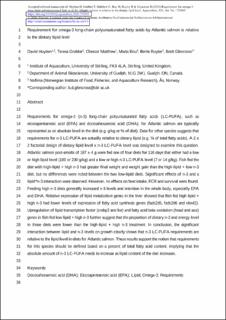| dc.description.abstract | Requirements for omega-3 (n-3) long-chain polyunsaturated fatty acids (LC-PUFA), such as eicosapentaenoic acid (EPA) and docosahexaenoic acid (DHA), for Atlantic salmon are typically represented as an absolute level in the diet (e.g. g/kg or % of diet). Data for other species suggests that requirements for n-3 LC-PUFA are actually relative to dietary lipid (e.g. % of total fatty acids). A 2 × 2 factorial design of dietary lipid level × n-3 LC-PUFA level was designed to examine this question. Atlantic salmon post-smolts of 187 ± 4 g were fed one of four diets for 116 days that either had a low or high lipid level (180 or 230 g/kg) and a low or high n-3 LC-PUFA level (7 or 14 g/kg). Fish fed the diet with high-lipid + high n-3 had greater final weight and weight gain than the high-lipid + low n-3 diet, but no differences were noted between the two low-lipid diets. Significant effects of n-3 and a lipid*n-3 interaction were observed. However, no effects on feed intake, FCR and survival were found. Feeding high n-3 diets generally increased n-3 levels and retention in the whole body, especially EPA and DHA. Relative expression of lipid metabolism genes in the liver showed that fish fed high lipid + high n-3 had lower levels of expression of fatty acid synthesis genes (fads2d5, fads2d6 and elovl2). Upregulation of lipid transcription factor (srebp2 and lxr) and fatty acid beta-oxidation (hoad and aco) genes in fish fed low lipid + high n-3 further suggest that the proportion of dietary n-3 and energy level in those diets were lower than the high-lipid + high n-3 treatment. In conclusion, the significant interaction between lipid and n-3 levels on growth clearly shows that n-3 LC-PUFA requirements are relative to the lipid level in diets for Atlantic salmon. These results support the notion that requirements for this species should be defined based on a percent of total fatty acid content, implying that the absolute amount of n-3 LC-PUFA needs to increase as lipid content of the diet increases. | |
